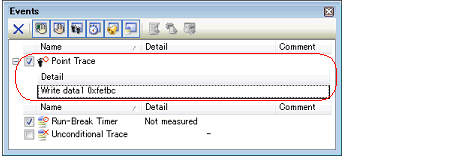Use one of the following methods to set a Point Trace event.
Also see "2.16.7 Notes for setting events" for details on Point Trace events (e.g. limits on the number of enabled events). |
[IECUBE] |
[Simulator] |
Perform this operation in the Editor panel/Disassemble panel in which the source text/disassembly text is displayed.
Follow the operation listed below from the context menu, in accordance with your desired access type, after selecting the variable or SFR as the subject to access.
Note, however, that only global variables, static variables inside functions, and file-internal static variables can be used.
Perform this operation in the Watch panel.
Select the watch-expression as the subject to access and perform the following operation from the context menu.
Note, however, that only global variables, static variables inside functions, file-internal static variables, and SFR can be used.
A watch-expression within the current scope can be specified. |
If you want to set a Point Trace event to a variable/SFR of 16-bit (2-byte) size when using IECUBE, register each address of the higher 8-bit and the lower 8-bit of the variable/SFR in the Watch panel directly as watch-expressions (see "2.10.6.1 Register a watch-expression").
Then, set a Point Trace event to each watch-expression by using the method described in "(2) For access to a registered watch-expression".

By performing the above operation, it is interpreted as if a Point Trace event has been set at the target variable/SFR/watch-expression, and it is managed in the Events panel (see "2.16 Manage Events" for details).
